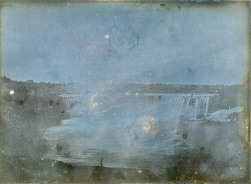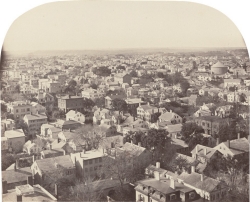Photography was introduced to the world in 1839. When the new medium arrived in the United States that year, it first established itself in major cities in the East. Photographers based in Philadelphia, New York, and Boston recorded the scenic vistas of tourist destinations such as the White Mountains and Niagara Falls, first photographed by Hugh Lee Pattinson in April 1840. Many early practitioners came to the medium from scientific or mechanical backgrounds, drawn to its seemingly magical ability to reproduce nature. And most — including Pattinson — adopted the daguerreotype, named after its French creator Louis-Jacques-Mandé Daguerre. This process fixed an image onto a silver-coated copperplate. Characterized by a mirrorlike surface and precise detail, the daguerreotype dominated photography in the United States for the next decade and a half.
The Early Decades: 1840s–1850s
The 1850s marked a period of transition. Processes that used paper or glass negatives to make positive prints began to be adopted more broadly. Although they lacked the crystalline precision of daguerreotypes, paper prints made from negatives were reproducible, a characteristic that encouraged the commercial potential of photography and the marketing of American scenes. By the end of the decade, paper prints had supplanted daguerreotypes.
Above: Hugh Lee Pattinson, British, 1796–1858, Horseshoe Falls, 1840, daguerreotype, Robinson Library, Newcastle University, England
Below: Francis Hacker, American, 1827–1904, Looking Northwest from Westminster Street, Providence, 1858–1860, salted paper print, National Gallery of Art, Washington, Pepita Milmore Memorial Fund

